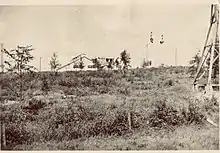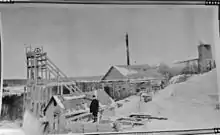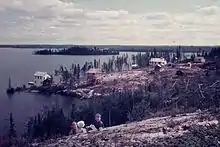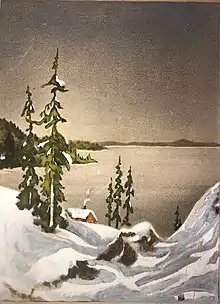Karl Brooks Heisey
Karl Brooks Heisey (1895, Markham, Ontario – 7 December 1937,[1] Toronto, Ontario) was a well-known Canadian mining engineer and mining executive in the 1930s.[2] Heisey pioneered the exploration and development of the Sanshaw/Red Lake metal deposits located in northwest Ontario. The Red Lake Mine is one of the richest gold mines in the world, still in production today with annual production of 600,000 ounces gold and over 11 million ounces produced to date.[3]
Karl Brooks Heisey | |
|---|---|
 Karl Heisey ca 1936 | |
| Born | 1895 Township of Markham, Ontario |
| Died | 1937 (aged 41–42) City of Toronto, Ontario |
| Resting place | Mount Pleasant Cemetery, Toronto |
| Occupation | Mining Engineer |
| Known for | Discovery and Early Development of Red Lake Mine |
Early life
Heisey was the son of farmers, Jacob Heisey (1856-1933) and Ida Lehman (1871-1941) and was raised in the Township of Markham, Ontario.[4] Heisey family members have farmed in various parts of York Region, including Gormley and Markham Village. Heisey (or Heise) and Lehman families were originally from Lebanon County, Pennsylvania and migrated to Upper Canada in the late 1700s.
He enlisted in the Signal Corps of the Canadian Expeditionary Force in 1917, during the First World War.[5] Heisey joined the Royal Flying Corps Canada (the training organisation of the British Royal Flying Corps) as a Cadet, flying out of Camp Borden, Ontario in 1918, and was demobilised at the end of the war as a Royal Air Force Second Lieutenant.[6] Heisey was of Dunkard descent (Brethren in Christ Church a pacifist German Anabaptist sect and did not see combat and was a flight instructor at Camp Borden.[7]
Heisey obtained a bachelor's degree in Applied Science from the College of Applied Science (Mining) at the University of Toronto in 1922. He was married to Alice Isabel Smith (1895–1968) in 1927.[8]
Mining career
 RAF 2nd Lt. Karl Heisey c.1920
RAF 2nd Lt. Karl Heisey c.1920 Karl Heisey freight canoe 1935
Karl Heisey freight canoe 1935 Heisey fishing in stream in Red Lake area 1936
Heisey fishing in stream in Red Lake area 1936
As both a highly experienced pilot and mining engineer Heisey was well positioned to participate in the Red Lake and Kirkland Lake Gold Rushes in northern Ontario in the 1930s. Red Lake was inaccessible by road until 1947 when Ontario Highway 105 was constructed and the only access prior to then was by boat or plane.[9] Kirkland Lake had no road access until 1937.[10]
Heisey engaged in geological surveys for the Ontario Ministry of Natural Resources between 1919 and 1922 in Kirkland Lake and West Shinintree and conducted magnetic surveys for discovery of gold with pyrrhotite iron.[11][12][13][14][15]
Following this, Heisey worked as an engineer with Argonaut Mines, Kirkland Lake from 1922 to 1923. In 1924 he was appointed chief engineer of Tough Oakes Gold Mines[1] and the same year he joined the Mond Nickel Company as exploration engineer in the Quebec field. Heisey opened his own office in Kirkland Lake in 1928,[2] coming to Toronto in 1930.
 Tough-Oakes Burnside Mine 1931
Tough-Oakes Burnside Mine 1931 Wood Kirkland Gold Mine 1928
Wood Kirkland Gold Mine 1928
Heisey was affiliated with numerous other mining corporations throughout his career where he held various roles, some of these corporations include: Manitoba and Eastern Mines Ltd.,[16] Marquette Long Lac,[17] and Russet Red Lake Syndicate.[18] His appointments with these mines included being in charge of surface work,[16] consulting and direction of a new extensive diamond-drilling program,[17] as well as consulting and analysis leading to recommendation of diamond drilling of a section of the property[18] respectively. Heisey also has authorship on an assessment report on Ossian Mines Ltd. for the Ministry of Northern Development and Mines of Ontario; his assessment outlined analysis of the mine as well as recommendations for future work.[19]
Sanshaw Gold Mine

Heisey was President of Sanshaw Mines, Limited, incorporated in 1936, which owned claims on White Horse Island, on Red Lake which was first staked by the Sanshaw Mines Syndicate.[21] 15 diamond drill holes were drilled totalling 1160 m in 1936.[22] He was the manager and driving force of the Sanshaw Gold Mine which was developed on White Horse Island during 1936–7. Heisey's crew uncovered a previously unknown well-mineralized shear and gold vein in 1936 which was the most important discovered up until that time in the Red Lake area.[23][24]
 Clearing land & burning timber Sanshaw Mine 1936
Clearing land & burning timber Sanshaw Mine 1936 Mine Shaft & Warehouse Sanshaw Mine 1936
Mine Shaft & Warehouse Sanshaw Mine 1936 Warehouse Barge Delivery, Sanshaw Mine 1936
Warehouse Barge Delivery, Sanshaw Mine 1936 Head frame over Mine Shaft 1937
Head frame over Mine Shaft 1937 Log Pier Sanshaw Mine 1936
Log Pier Sanshaw Mine 1936
Buildings constructed on the property included a bunk-house, two-storey office and warehouse, ice-house, cookery, directors' lodge, manager's residence, blacksmith shop, powder magazine, detonator-house and dry-house.[13] A 35-foot shaft was sunk on White Horse Island in 1937.

Operations ceased in September 1937 and Heisey died shortly thereafter in December of that year at the age of 42. Heisey is buried at Mount Pleasant Cemetery, Toronto in a family plot, where as his parents are buried in Quantztown Cemetery in Markham, Ontario and earlier members of the Heisey or Heise in Heise Hill Cemetery in northwest Markham.[25]
 Sanshaw Gold Mine Site 1938 year after closure, Howey Bay background
Sanshaw Gold Mine Site 1938 year after closure, Howey Bay background Man with Stag on dog sled, Warehouse, Sanshaw Gold Mine, 1938[26]
Man with Stag on dog sled, Warehouse, Sanshaw Gold Mine, 1938[26]
The Sanshaw Mine name was a pun on the name of John Whitman Shaw, who was a consulting mining engineer operating in the Red Lake area. The mine was proceeding with diamond drilling and sinking a shaft "sans" (i.e. without) Shaw. Shaw's nickname in the mining industry was "turn em down Shaw" referring to his lack of support for many new mine proposals. The White Horse Island discovery was one of the few in the Red Lake area that didn't use John Shaw's services. [27]
Orlac Gold Mines
Mining at Sanshaw was not restarted until after World War II when it reopened as Orlac Red Lake Mines, Limited ("Orlac").[28] During the period 1946-47 Orlac deepened the shaft to 139 metres and established levels at 68 and 106 metres (termed the Orlac deposit). During this period, Orlac drilled 701 metres of underground development, 15 surface holes that totaled 1,655 metres, and 523 metres in 54 underground drill holes.[29] [30]
 Orlac Gold Mines head shaft and warehouse February , 1946
Orlac Gold Mines head shaft and warehouse February , 1946 Orlac Gold Mines head shaft, offices and bunkhouse February , 1946
Orlac Gold Mines head shaft, offices and bunkhouse February , 1946
References
- "Noted Mine Engineer Karl B. Heisey Dead". Toronto Daily Star. Toronto. 8 December 1937. p. 12. ProQuest 1433959295.
- "Mining Executive Karl Heisey, Dies", Ottawa Citizen, 8 December 1937
- "Archived copy". Archived from the original on 20 September 2016. Retrieved 16 January 2017.CS1 maint: archived copy as title (link)
- "UELAC.org - Loyalist Trails newsletter Online edition 2014 Archive". Uelac.org. Retrieved 14 October 2017.
- https://www.bac-lac.gc.ca/eng/discover/military-heritage/first-world-war/personnel-records/Pages/item.aspx?IdNumber=461550
- "Memoranda". The London Gazette. thegazette.co.uk. 12 March 1920. p. 3193. Retrieved 24 March 2015.
- "Re: Heise's of Ontario, posted - Genealogy.com". Genealogy.com. Retrieved 14 October 2017.
- "Toronto 1927, part 7". homepages.rootsweb.ancestry.com. Retrieved 14 October 2017.
- "Ontario Highway 105 History - The King's Highways of Ontario". Thekingshighway.ca. Retrieved 14 October 2017.
- "Ontario Highway 66 History - The King's Highways of Ontario". Thekingshighway.ca. Retrieved 14 October 2017.
- Sabina, Queen's Printer, Anna P. (2003). "Roches et Mineraux, Report 77" (PDF). Geological Survey of Canada. p. 196. Archived from the original (PDF) on 2 April 2015. Retrieved 2 March 2015.
- "Mining Executive Karl Heisey dies". Ottawa Citizen. 8 December 1937. p. 5.
- "FORTY-SEVENTH ANNUAL REPORT of the ONTARIO DEPARTMENT of MINES" (PDF). Geologyontario.mndmf.gov.on.ca. Retrieved 14 October 2017.
- Who's Who in Canada 1936–37 Including The British Possessions in the Western Hemisphere, Edited by E.M. Greene, Twenty-Fifth year of Issue, Published by International Press Limited, Toronto, Ontario, Canada 1937
- "Mine's President Dies Toronto", Winnipeg Tribune 8 December 1937 p. 17
- "The Winnipeg Tribune from Winnipeg, on September 18, 1928 · Page 21". Newspapers.com. Retrieved 14 October 2017.
- "The Winnipeg Tribune from Winnipeg, on November 11, 1936 · Page 14". Newspapers.com. Retrieved 14 October 2017.
- "The Winnipeg Tribune from Winnipeg, on October 2, 1937 · Page 23". Newspapers.com. Retrieved 14 October 2017.
- "Ossian Mines Ltd" (PDF). Geologyontario.mndmf.gov.on.ca. Retrieved 14 October 2017.
- Heisey's 3 children in foreground left to right Lawrence Heisey , Karl Jr. wearing hat and Alan Milliken Heisey Sr..
- "Frontline Gold Corp - News Releases - Frontline Acquires Red Lake Mining Patents Between Goldcorp and Premier Gold Property Boundaries - Sat Oct 14, 2017". Frontlinegold.com. Archived from the original on 17 February 2017. Retrieved 14 October 2017.
- "Sanshaw Locates New Shear Zone", The Northern Miner, 10 September 1936 p. 21
- "Archived copy". ProQuest 1350960999. Cite journal requires
|journal=(help) - https://www.genealogy.com/forum/surnames/topics/heise/134/
- man in picture is Stanley Harper brother in law of Karl Heisey
- Industry in the Wilderness: The People, the Buildings, the Machines By Frank Rasky 1983 page 51
- "A cabin on White Horse Island - The Northern Sun". Thenorthernsun.com. Retrieved 14 October 2017.
- http://www.frontlinegold.com/s/NewsReleases.asp?ReportID=718609&_Type=News-Releases&_Title=Frontline-Acquires-Red-Lake-Mining-Patents-Between-Goldcorp-and-Premier-Gol Archived 5 November 2016 at the Wayback Machine...
- https://www.redlakemuseum.com/orlacred-lake-mine.html